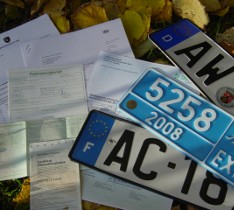Homologation – vehicle documentation for Europe!
Homologation means the technical modification of a non-European car which is to be registered in Germany, Switzerland or another European country. It is not the modification itself which is particularly difficult but rather providing the necessary documentation and establishing the technical information, such as the exhaust emission values. The following modifications are often required:
- Retrofit rear fog-light. This should be properly integrated and not be below the bumper (as on the classic VW Beetle).
- Change the red indicator lights to orange (common for US imports).
- Retrofitting of a reversing light for engaged reversing (also US imports).
- Headlight range adjustment is compulsory in the EU and sometimes has to be retrofitted. Xenon headlights require automatic headlight range adjustment.
- In the EU xenon headlights must be fitted with an obligatory headlight washer unit which is often missing in vehicles from outside Europe.
- The vehicle identification number (VIN) has often to get imprinted in other parts of the vehicle body.
- The EU does not permit dark-tinted privacy glass films, if necessary they must be removed.
In many cases the rear fog light is the biggest issue, further alterations are rare in the cars we offer. However, the required documentation, which is necessary for European vehicle documentation, is extensive:
- An exhaust emissions report is almost always required and costs much more than, for example, than a regular usual emissions test. The car is examined in a special laboratory. During the process the car tank is filled up then the assessors allow the engine to run for 48 hours whilst sensors measure the emissions performance, including CO2 emissions. The car is then given the corresponding Euro standards classification between II and VI. We already have the respective reports for many models so an expensive examination is often not necessary.
- An EMC report has also been compulsory for several years ("electro magnetic compatibility report").
- A light report is regularly required.
- Some EU countries also require a noise report.
- Full assessment in accordance with §21 by the TÜV or Dekra.
- Issuance of the vehicle documentation, e.g. the “Vehicle registration certificate Part 1+2” in Germany (previously: “Vehicle registration document and vehicle title”), by an official registration office.
We will have the measures carried out for you, they will take around 14 days and your car must be with us in Hagen (close to Dortmund, Germany) for this.
Important things to know about homologation
Of course there are cars which do not fulfil the required standards and cannot be appropriately modified. Assessors, like registration offices, differ with regards to this, whether it concerns a new car import or the import of a used car by, for example, a repatriate. Again, with regards used cars, age plays a large part. The newer the vehicle is, the more stringent the requirements are. Isuzu models or a Toyota Land-Cruiser 200 from Dubai, for example, cannot be registered as new cars in the EU and also cannot be converted. Even in these cases there are numerous special regulations for repatriates which you simply have to know about. We have good contacts with various registration offices and generally achieve exemption approval for such vehicles for clients who have migrated.
Our contact with the assessor and experts is very often decisive in the registration, as we can persuade them of certain, necessary gestures of goodwill. We often use the Kia Sorento as an example, where the import models frequently lack the EU certification mark on the headlamps. We can regularly satisfy the assessor that the Sorento headlamps on the imported car are structurally identical to those on the European models. If an assessor did not confirm this, then the headlamps would have to be changed (price: 700 Euros, even more for xenon).
The EU emission standards pose another set of problems, Euro IV applies for registrations from 01.01.2007 in Europe, Euro V for registrations from 01.01.2012. If for example your vehicle only fulfils EURO III but was registered abroad before 01.01.2007, you can register your car in Europe with its own emission class as EURO III even though this is no longer sufficient! It is stipulated that “on first entering the market” (registration) a car in Europe must now fulfil EUR V.
There are other exceptions: repatriates are allowed to bring almost all cars with them as relocation goods using a certificate of exemption in Europe, regardless of how poor the pollution emissions are and regardless of when it was first registered. However, it is noted in the car documents that the car may not be sold on within the EU except to family members. Don't forget the emission sticker! You are not permitted to travel within the inner-city area of many European cities if your car is EURO III or less. These areas will soon also exclude the EURO IV class. Additionally, the lower your EURO classification, the more car tax you will be due to pay. Furthermore, vehicle insurance is often more expensive for “exotic” cars. Insurance companies use the so-called “exotics list”, if the key numbers are also “zeroed” in the car documents.







